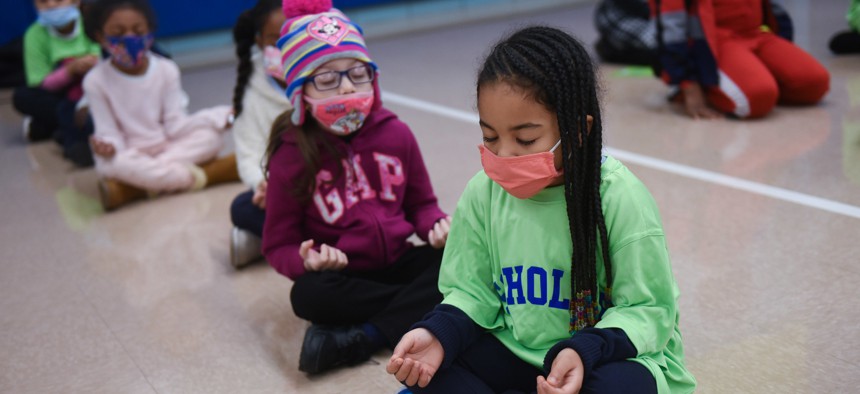Education
New York students face anxiety and fear as they continue to navigate pandemic schooling
Kids have had a rough couple of years of instability and loss. Behavioral issues and academic uncertainty continue to impact their mental health.

The pandemic continues to weigh heavily on the mental health of the city’s 1.1 million school children. Michael Appleton/Mayoral Photography Office
The pandemic continues to weigh heavily on the mental health of the city’s 1.1 million school children, their parents and especially on the teachers charged with keeping them on academic track. Deaths of friends and loved ones, new variants and the possibility of infection they bring, changes in protocols like mask wearing or isolation time after infection, and the endless debates about in-person or remote learning are just some of the issues impacting the school communities.
New York City Council Member and former Manhattan Borough President Gale Brewer notes that even deciding how to mark a student who misses class absent can impact the student’s future. “Maybe the parents want the child to stay home because there was an outbreak at school and they’re afraid the child will get infected and bring it home,” Brewer said. “But right now, if a student is not sick herself, being marked absent can impact their grades and academics.”
Teachers must deal with these stresses and a variety of other issues, from covering for sick or absent colleagues and keeping often absent students on academic schedule, as well as the prepandemic issues found in all schools, like food insecurity in student homes and parental abuse, which can be exacerbated by at home learning in close quarters. For those and other reasons, mental health has become an even more important issue in schools.
Hundreds of anxious New York City public school students walked out of class on Jan. 11 to demand that online classes be offered to those who wanted to stay at home. The students cited teacher absences and the fear of widespread infection from the omicron variant of COVID-19 among their reasons for wanting remote classes. Similar protests occurred in other cities across the nation, with some students threatening to boycott in-person classes over omicron.
“Students have faced immense challenges over the course of the pandemic, and many have been impacted by the pain, stress and trauma the pandemic has caused New Yorkers,” said Department of Health and Mental Hygiene spokesperson Victoria Merlino.
In addition, some schools have been reporting higher incidences of violence and acting out since students returned to in-person classes. Other schools have reported students entering school in pajama bottoms, and children displaying behavior that is typical not of their age group, but of the last age group with which they interacted during in-person classes. Mental health is also a concern for colleges across the country, where administrators fear that isolation caused by remote learning has left many students feeling depressed and even suicidal.
How New York City plans to deal with such issues is not known at this time. The Adams administration and the Department of Education did not respond to numerous emails seeking comment on how the pandemic is driving mental health issues affecting the city’s school children.
But United Federation of Teachers Associate Executive Director for United Community Schools Christine Schuch spoke to City & State about what members are seeing in the city’s community schools, schools that remain open longer than regular public schools and offer more social services. Schuch manages UFT social workers and professionals working in those schools.
“In elementary schools, students are experiencing anxiety and fear,” Schuch said. “There is the stress of walking into a school and not feeling entirely safe. Then you have the students who have experienced great loss, and a lot of disruption, as we all have, but it manifests differently with children.
“In middle schools and high schools, there is still stress and anxiety and trauma as well as a little uptick in violence and in suicidal thoughts. Some of the stresses are kind of leveling off now, but you add returning to school while dealing with a new variant, and there is more stress,” she added.
Teachers “are equally stressed out,” Schuch said. “They’re trying to deal with the same situations, and they or their colleagues are getting sick and they have to figure out how to cover for them.”
The pandemic prompted the UFT to “put in much more social and emotional programming for the staff, so they can support the students, for the parents, so they can also support themselves and their children, and then for the teachers,” she said. That translates to more group and individual counseling sessions for students and more home calls for parents.
The UFT also has 45 staff members, six of them social workers serving with DOE social workers, manning the programs in 32 schools. “Our social workers have been doing much more check-ins,” during the pandemic, she said. “They touch every kid in the building to see how they’re doing, and they’re doing a lot more groups, so you can really work one-on-one with the students in the groups.”
Social workers are developing programs for parents as well, Schuch said. “Many parents just want to talk to somebody, to say this is hard,” she said.
Community schools have also increased counseling for school staff, offering the same social and emotional programming the students and families receive. “We’ve been having a lot more meetings to check in and see how the staff are doing, and make sure they get the space and time to take care of themselves,” she said.
“They’re making it work because they have to,” she added.

